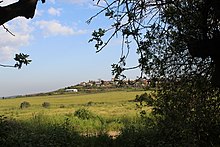Moshav





Amoshav(Hebrew:מוֹשָׁב,pluralמוֹשָׁבִיםmoshavim,lit."settlement, village" ) is a type ofIsraelivillage or town orJewishsettlement, in particular a type ofcooperativeagricultural community of individual farmspioneeredby theLabour Zionistsbetween 1904 and 1914, during what is known as thesecond wave ofaliyah.[1]A resident or a member of a moshav can be called a "moshavnik" (מוֹשַׁבְנִיק). There is an umbrella organization, theMoshavim Movement.
The moshavim are similar tokibbutzimwith an emphasis on community labour.[2]They were designed as part of the Zionist state-building programme following the green revolutionYishuv(Hebrewfor 'settlement') in theBritish Mandate of Palestineduring the early 20th century, but in contrast to thecollective farmingkibbutzim, farms in a moshav tended to be individually owned but of fixed and equal size. Workers produced crops and other goods on their properties through individual or pooled labour with the profit and foodstuffs going to provide for themselves. Moshavim are governed by an elected council (Hebrew:ועד,romanized:va'ad,lit. 'committee'). Community projects and facilities were financed by a special tax (Hebrew:מס ועד,romanized:mas va'ad,lit. 'committee tax'). This tax was equal for all households of the community.
Types
[edit]There are several variants, of which the most common are:
- Moshav ovdim(Hebrew:מושב עובדים,lit. 'workers' moshav'), a workers' cooperative settlement. This is the more numerous (405) type and relies on cooperative purchasing of supplies and marketing of produce; the family or household is, however, the basicunit of productionand consumption.
- Moshav shitufi(Hebrew:מושב שיתופי,lit. 'collective moshav'), a collectivesmallholders' settlement that combines the economic features of akibbutzwith the social features of a moshav. Farming is done collectively and profits are shared equally. This form is closer to the collectivity of the kibbutz: although consumption is family- or household-based, production and marketing are collective. Unlike the moshav ovdim, land is not allotted to households or individuals, but is collectively worked.
- Moshbutzis a mixed moshav-kibbutz type of settlement.
History
[edit]
The first moshav,Nahalal,was established in theJezreel Valley(also known as the Valley of Esdraelon) on September 11, 1921. By 1986 about 156,700 Israelis lived and worked on 448 moshavim; the great majority of these are divided among eight federations.
Because the moshav organisation retained the family as the centre of social life, it was much more attractive to traditionalMizrahiimmigrants in the 1950s and early 1960s; they eschewed bold experiments, like communal child-rearing or equality of the sexes, practiced by communal kibbutz. These so-called "immigrants' moshavim" (Hebrew:מושב עולים,romanized:moshav olim) were one of the most-used and successful forms of absorption and integration of Mizrahi Jewish immigrants; it allowed them a much steadier ascent into themiddle classthan did life in somedevelopment towns.
Since theSix-Day Warin 1967, both moshavim and kibbutzim have relied increasingly on outside—includingPalestinian—labour. Financial instabilities in the early 1980s hit many moshavim hard, as did their high birth rate and the problem of absorbing all the children who might wish to remain in the community. By the late 1980s, moshav members increasingly came to be employed in non-agricultural sectors outside the community, so that some moshavim began to resemblesuburbsorcommuter townswhose residents commute to work. In general, moshavim never enjoyed the "political elite" status afforded to kibbutzim during the period ofIsraeli Labor Partydominance; correspondingly the moshavim did not endure the decline in prestige experienced by kibbutzim in the 1970s and 1980s, during the period ofLikuddominance starting in 1977.
See also
[edit]References
[edit]- ^Sofer, Michael; Applebaum, Levia (1 July 2006)."The rural space in Israel in search of renewed identity: The case of the moshav".Journal of Rural Studies.22(3): 323–336.Bibcode:2006JRurS..22..323S.doi:10.1016/j.jrurstud.2005.10.004.ISSN0743-0167.
- ^Sofer, Michael (December 2005)."The future of family farming in Israel: the second generation in the Moshav".The Geographical Journal.171(4): 357–368.Bibcode:2005GeogJ.171..357S.doi:10.1111/j.1475-4959.2005.00171.x.ISSN0016-7398.
Bibliography
[edit]- Helen Chapin Metz,ed., Chapter 2 "Kibbutz and Moshav".Israel: A Country Study.Federal Research Division,Library of Congress.1990.
External links
[edit] Media related toMoshavimat Wikimedia Commons
Media related toMoshavimat Wikimedia Commons
